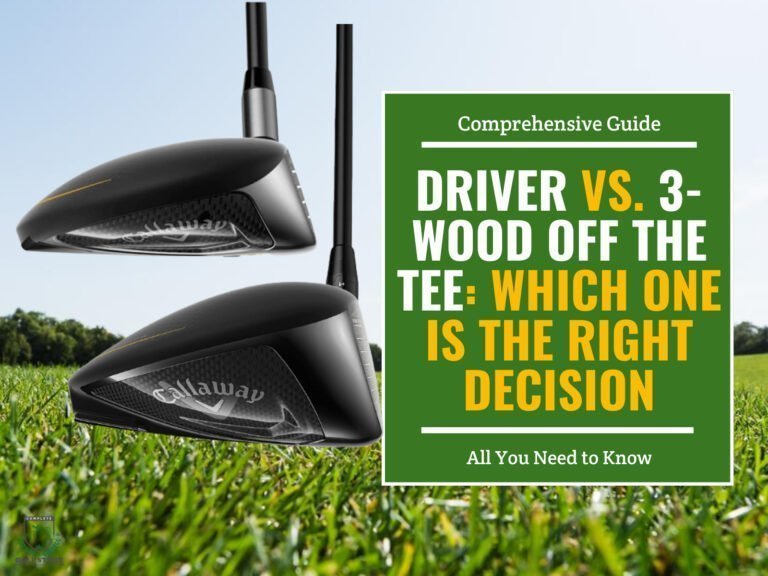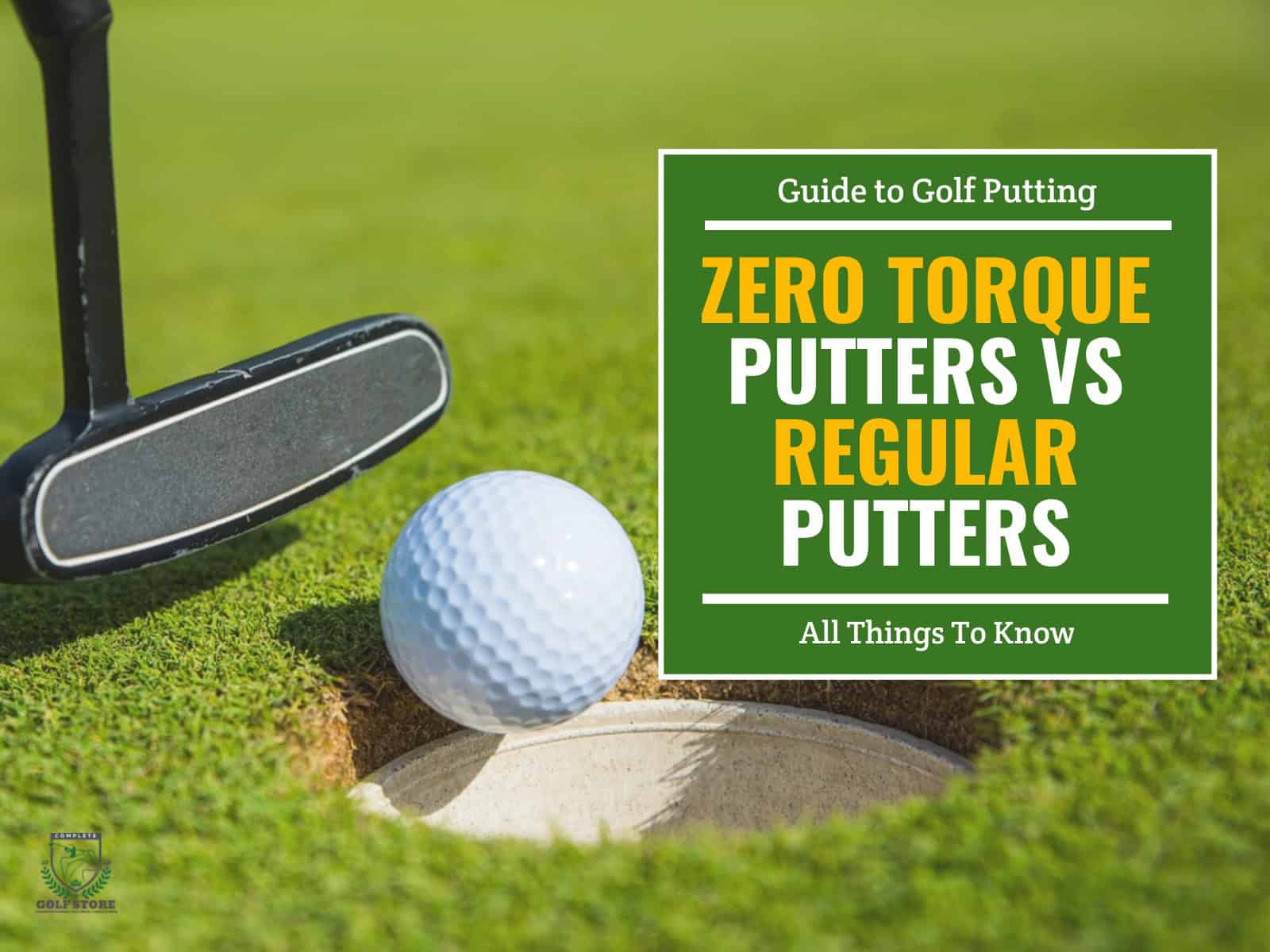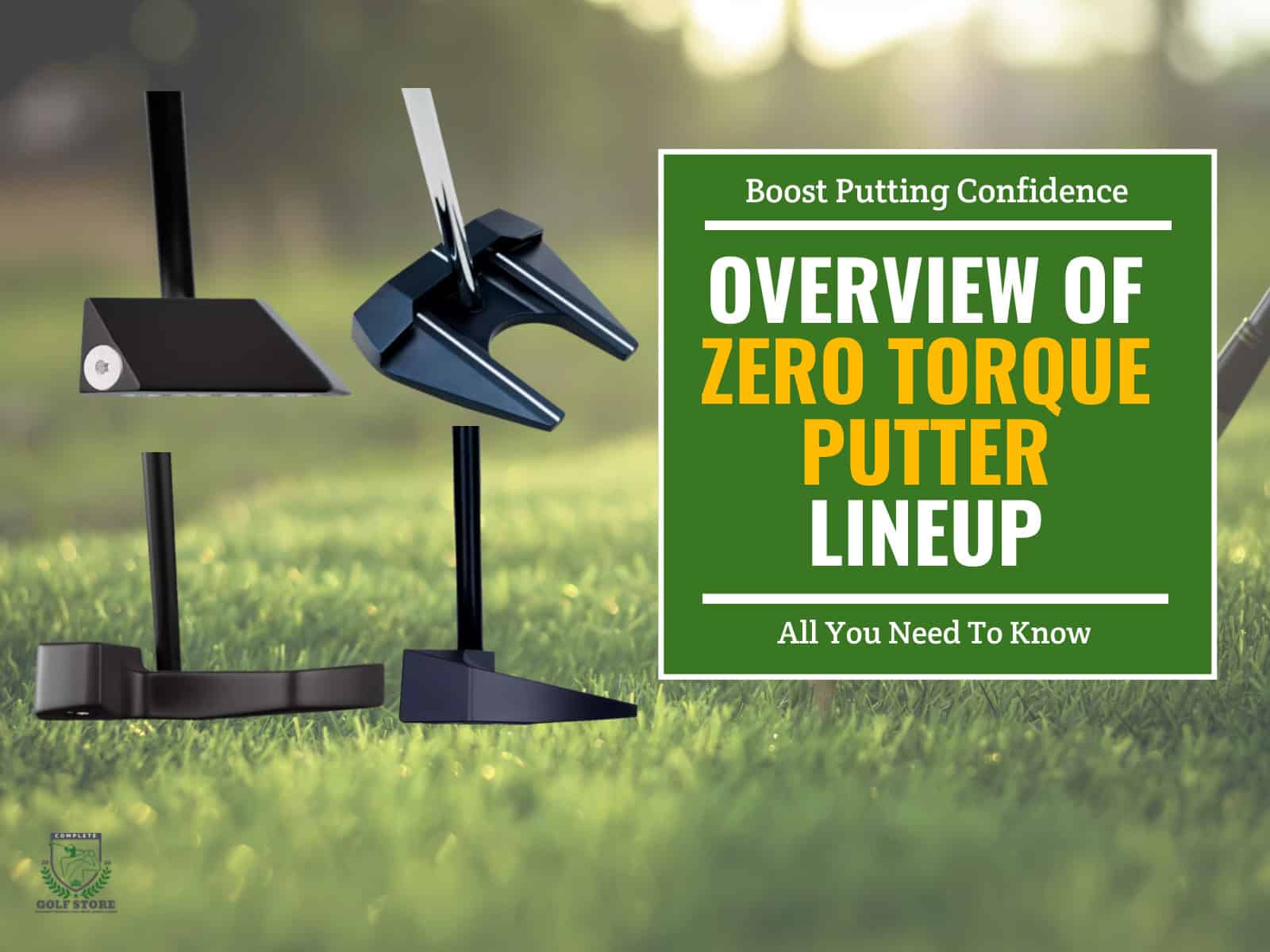Golfers are faced with a common dilemma: should they use a driver or a 3-wood for their tee shots? Both clubs have their advantages and disadvantages, and choosing the right one can make a big difference in your game.
The driver is the longest club in a golfer’s bag, and it’s designed to hit the ball as far as possible. On the other hand, the 3 wood is shorter than the driver, but it’s easier to control and can be more accurate.
So, which one should you choose for tee shots? And when? In this article, we’ll take a closer look at the pros and cons of each club and help you make the right decision for your game.
- 1) Driver vs 3 Wood: Detailed Breakdown.
- 2) Driver vs 3 Wood: Distance
- 3) Driver vs 3 Wood: Accuracy Comparison Chart
- 4) Driver vs 3 Wood: Fairway Hit Percentage Comparison Chart
- 5) Examples Of Situations Where One Club May Be More Advantageous Than The Other
- 6) What About Hybrids?
- 7) The Bottom Line
Driver vs 3 Wood: Detailed Breakdown.

While both drivers and 3 Woods are useful off the tee, there are key differences that make them suited to different situations and skill levels.
Let’s break down the differences between these two clubs, so you can choose the best one for your game.
Clubhead Size And Shape
When it comes to choosing between a driver and a 3 wood, clubhead size and shape play a crucial role in balancing forgiveness and control.
Modern drivers tend to have larger clubheads, offering greater forgiveness for off-center hits, but sacrificing control.
On the other hand, 3 wood clubheads tend to be smaller, offering greater precision but less forgiveness.
The size of the clubhead can affect the center of gravity (CG) and the moment of inertia (MOI), influencing the ball’s launch angle, spin, and trajectory.
Larger clubheads have a higher moment of inertia, which makes them more forgiving on off-center hits.
However, they also usually have a lower center of gravity, which can result in a higher launch angle and more spin, potentially sacrificing control.
Clubhead shape is another factor to consider when balancing forgiveness and control. Golfers have the option of choosing from shapes like pear, round, and square, each with unique features that can affect their performance.
For example, the pear-shaped design has a higher center of gravity and smaller clubface, making it better suited for more advanced golfers who prioritize control.
Meanwhile, the round-shaped design has a larger clubface and lower center of gravity, providing more forgiveness for off-center hits.
Shaft Length

The general rule is that longer shafts generate more power and distance, while shorter shafts offer greater control and accuracy. A driver’s shaft is longer than that found on a 3-Wood.
If you are an amateur golfer with slower swing speeds, a shorter shaft is recommended to improve control and accuracy. Shorter shafts are easier to swing, allowing for consistent contact with the golf ball and straighter shots. Similarly, a scratch golfer with faster swing speeds can benefit from a shorter shaft to enhance their precision.
On the other hand, a longer shaft can provide more power and distance, making it a popular choice among golfers looking to maximize their distance off the tee. However, longer shafts are more difficult to control, requiring greater skill to consistently hit straight shots.
It’s essential to experiment with different shaft lengths to find the perfect balance between power and precision, which requires analyzing your swing speed, skill level, preferred ball flight, and the club’s loft angle.
Distance
The driver is the clear go-to club for most golfers to achieve maximum distance off the tee. Its long shaft and low loft angle allow for increased clubhead speed and maximum distance.
In addition to its design, the advances in clubhead and shaft technology have contributed to the driver’s dominance on the golf course. Club manufacturers have incorporated lower centers of gravity, which help generate a higher launch angle and lower spin rate resulting in extra distance.
Shaft technology has also evolved to accommodate faster swing speeds, so the golf ball launches higher, spins less, and goes further. Higher launch angles have also been achieved due to a change in the loft angle, which maximizes the ball’s carry and roll.
All of these factors combined with the driver’s larger clubhead relative to a 3-wood (or hybrid club) make it easier to make consistent contact with the ball for most skill levels.
Ball Flight And Trajectory

There are distinct differences between a driver and a 3 wood in terms of ball flight and trajectory. The driver is designed with a lower loft and longer shaft length, resulting in a longer (and lower) ball flight and longer carry distance off the tee.
The lower loft allows for a more optimal launch angle, which generates more distance with minimal spin. Additionally, the longer shaft length increases club head speed, which translates into higher ball speeds and more distance.
On the other hand, a 3-wood typically has a higher loft and shorter shaft length, which creates a higher ball flight (with a more curved trajectory) and less distance.
However, the increased loft allows for more backspin, which creates a more controlled shot for players who struggle with accuracy. The shorter shaft length also increases accuracy and consistency, making it a more reliable club off the fairway or when hitting tight fairways.
Adaptability
While the driver is often considered the go-to club for tee shots, the 3 wood offers a more compact and versatile option for a variety of shots off the fairway.
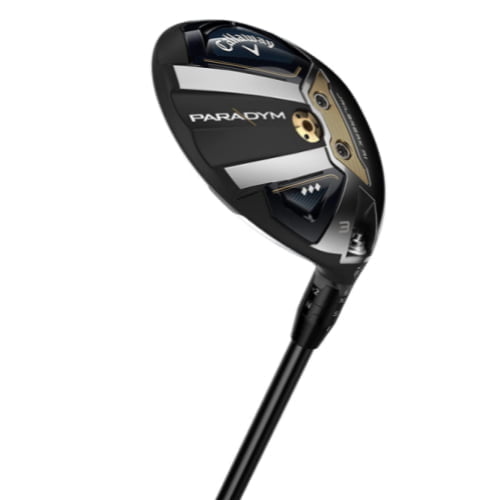
The 3 wood’s shorter shaft and smaller clubhead size make it easier to control, especially for golfers with slower swing speeds. It’s also great for navigating tight fairways, as it allows for greater accuracy. The added loft of a 3 wood can also help amateur golfers get more height on their shots, while still maintaining some distance.
On the other hand, the driver is unbeatable for distance off the tee. With a longer shaft and larger clubhead size, it generates greater clubhead and ball speeds, resulting in more distance off the tee. The driver is also a great choice for hitting long, straight shots on wide-open fairways.
However, both clubs offer shot options that can be adapted to different course layouts and playing conditions. Below are some examples:
- 3 wood on tight fairways: When faced with a narrow fairway or a confined tee shot, a 3 wood can help you navigate the hazards and place the ball accurately on the fairway.
- Driver on wide-open fairways: When the fairway is wide open, the driver can help you maximize your distance and get as close to the green as possible.
- 3 wood on approach shots: Sometimes, you don’t need maximum power, but rather more accuracy. In these cases, a 3 wood can be your go-to club for approach shots, as its smaller clubhead size makes it easier to hit consistent shots.
- Driver on tee shots: When distance is your main concern on the tee, the driver should be your choice. With modern drivers, you can adjust loft angle and trajectory, so the ball will gain extra distance while still maintaining a good ball flight.
By understanding the different shot options available with each club, you can use them to your advantage on the golf course and improve your game.
Course Layout
When selecting your club based on the course layout, you’ll need to consider several factors to determine whether a driver or 3 wood is the better choice off the tee.
For example, shorter shafts and fairway woods are better suited for distance control, while drivers are ideal for maximum distance. Consider your skill level and the distance you need to hit the ball, especially when accounting for obstacles such as bunkers or water hazards.
Additionally, the shape of the fairway can affect your decision. For example, a dogleg or narrow landing area may require a 3 wood to help you shape your shot and navigate the fairway successfully. Conversely, a more direct line to the hole may require the use of a driver.
However, some courses may offer wider fairways or fewer hazards, making a driver the better choice to get the ball down the course as quickly as possible.
It’s important to remember that golfers may need to switch between the two clubs during a round based on the distances and challenges of each hole. This can help ensure consistent contact and ball flight, regardless of the conditions presented on each hole.
Tolerance
Tolerance, or forgiveness, is the ability of a club to perform consistently even when the ball is not struck perfectly on the sweet spot. This is particularly important for amateur golfers or those with slower swing speeds who tend to make off-center contact.
So, how does tolerance differ between fairway woods and drivers?

The fact that drivers have bigger club heads and club faces compared to 3-woods means that they have more surface area to hit the ball properly because they provide a larger sweet spot. This makes drivers more forgiving than 3-Woods, with their smaller heads, faces and sweet spots.
Technological advancements have also contributed to making drivers even more forgiving and easier to swing; many manufacturers use movable weight systems and adjustable loft and lie angles to help lower the center of gravity, increase MOI and add draw bias that can fix players’ mistakes causing slices or hooks.
With that said, despite having a smaller sweet spot, a 3-wood is shorter and smaller (lighter), which makes it easier to swing than the big stick and reduces the risk of mishits. This, too, contributes to the 3-Wood’s forgiveness.
Driver vs 3 Wood: Distance
The following is a chart showing median and max distances for drivers and 3-Woods:
| Club | Median Distance | Maximum Distance |
|---|---|---|
| Driver | 200-260 yards | 300+ yards |
| 3 Wood | 180-240 yards | 280+ yards |
Note: The median and maximum distances are influenced by factors such as skill level, swing speed, and loft angle.
Drivers are designed for maximum distance off the tee and offer more distance potential than 3-woods. The median distance for a driver is generally between 200-260 yards, while the maximum distance can exceed 300 yards for skilled golfers with higher swing speeds. On the other hand, a 3-wood offers slightly less distance potential with a median distance of 180-240 yards and a maximum distance of around 280 yards.
The loft angle and clubhead speed can significantly impact the distance capabilities of both the driver and 3 wood. A driver typically has a lower loft angle of around 9-13 degrees, which helps create a lower ball flight and more distance potential. In comparison, a 3 wood has a higher loft angle of around 13-16 degrees, which can create a higher ball flight and more backspin, resulting in less overall distance but more control.
Driver vs 3 Wood: Accuracy Comparison Chart
When comparing the accuracy of a driver versus a 3 wood, several factors come into play. This chart will highlight the key differences between the two clubs to give you a comprehensive understanding of their accuracy capabilities.
| Factor | Driver | 3 Wood |
|---|---|---|
| Clubhead Size | Larger and more forgiving (larger sweet spot), less control | Smaller and easier to control |
| Shaft Length | Longer- harder to swing | Shorter- easier to swing |
| Loft Angle | Lower | Higher |
| Ball Trajectory | More prone to producing slices or hooks | Generally produces a straighter shot than the driver |
The difference in clubhead sizes is arguably the most significant factor dictating the accuracy of both clubs. The 3 wood’s smaller head makes it easier to control, giving it a more accurate shot compared to the larger driver head.
Furthermore, the shorter shaft of the 3 wood makes it more manageable for golfers with slower swing speeds, reducing the chances of missing the sweet spot.
Another key distinction is the loft angle. Typically, a higher loft produces a higher trajectory with less roll, making the 3 wood ideal for hitting off the fairway.
The driver’s lower loft angle, on the other hand, promotes a lower trajectory with more roll, making it an excellent choice for tee shots.
Overall, the 3 wood tends to be more forgiving due to its smaller head, shorter shaft, and higher loft angle. The driver is more forgiving in terms of having a larger sweet spot, but its length and weight make it less manageable and harder to hit.
Driver vs 3 Wood: Fairway Hit Percentage Comparison Chart
The fairway hit percentage comparison chart below shows that, on average, a 3 wood has a higher fairway hit percentage than a driver. These are the numbers we had during our own tests.
| Club | Fairway Hit Percentage |
|---|---|
| Driver | 49% |
| 3 Wood | 50% |
Based on the fairway hit percentage comparison chart, the 3 wood is a more accurate club for hitting the fairway. However, the difference is small, but costs a bit less total and carry distances. This small advantage is mainly due to the better control that helps reduce dispersion and keep your tee shots on the fairway. The ball’s curve was also higher in driver shots (causing the dispersion) and lower with the 3-Wood (less dispersion & more hits on the fairway).
In the end, you need to ask yourself: Is the small gain in accuracy and fairway hits worth sacrificing some distance? If the answer is yes, then you should definitely use a 3-Wood off the tee. Otherwise, your driver is the one!
Examples Of Situations Where One Club May Be More Advantageous Than The Other
The following are some specific situations where one club may be more advantageous than the other:
- Tight fairways: If the course has narrow fairways, a 3-wood may be a better option as it has a smaller head size, making it easier to hit the ball straight. This is especially true for novice golfers who may struggle with the larger driver head.
- Extra distance: If you need to hit the ball as far as possible, the driver is the way to go. The longer shaft and lower loft allow for maximum clubhead speed, resulting in more distance off the tee.
- Windy conditions: If the wind is strong, a 3-wood can be more advantageous as it has more loft which creates a higher ball flight. This higher trajectory will help the ball stay in the air longer, potentially resulting in a longer carry.
- Elevated tees: When teeing off from an elevated position, a driver can provide the perfect blend of distance and accuracy. By hitting the ball high and far off the tee, you can set yourself up for a shorter approach shot to the green.
- Turning fairways: If you need to shape your shot around a dogleg or avoid a hazard, a 3-wood can be more versatile thanks to its added control.
Here is an interesting example; during the 2019 Augusta National Masters Tournament, Tiger Woods used a 3 wood off the tee on the famous 13th hole. The hole is a slight dogleg to the left, and Woods wanted to avoid hitting his ball too far right and into the trees. His decision to use a 3 wood paid off, as he hit a straight shot down the middle of the fairway and went on to birdie the hole.
What About Hybrids?
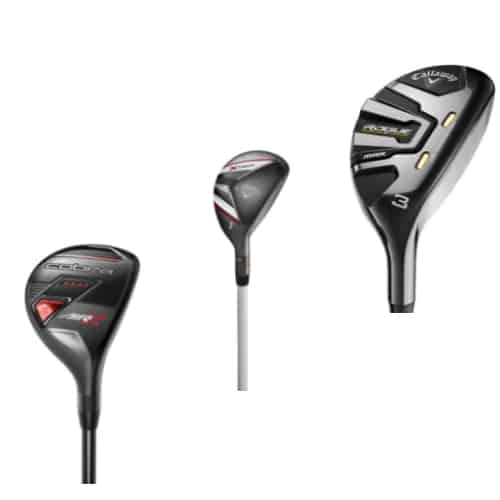
In the driver vs 3 wood debate, hybrids are often thrown into the mix as a viable option for golfers of all skill levels.
Hybrids are a cross between irons and fairway woods, designed to provide the best qualities of both in a single club. They typically have a smaller clubhead size and shape than fairway woods, but are larger and more forgiving than irons. They also have a shorter shaft length than fairway woods and drivers, making them easier to control.
Hybrids typically have a loft angle between 14 and beyond 33 degrees. This makes them a great option for approaches to the green or shots from the rough. However, they may not have the distance capabilities of a driver or 3 wood, with a maximum distance of around 200-220 yards for most golfers.
Despite their limitations in distance, hybrids offer a number of benefits for many golfers. For example, their small clubhead size and shape make them easier to control and hit consistently, particularly for those with slower swing speeds. They are also versatile, allowing for a variety of shots from different lies on the course.
However, hybrids may not be ideal for longer shots from the tee or from the fairway, where a 3-wood or driver would be a better choice. Additionally, hybrids may not provide the same level of ball speed and launch angle as a traditional fairway wood or driver.
The Bottom Line
In the end, there is no right answer when choosing between a driver or a 3 wood for tee shots. The decision comes down to personal preference and the specific situation at hand.
Both clubs have their advantages and disadvantages, and it’s up to you to determine which one will best suit your game.
However, no matter which club you choose for your tee shots, the most important factor is practice. After all, the best way to become an expert in any sport or activity is to put in the time and work necessary to hone your skills. Taking a few extra minutes each day to practice with both a driver and a 3 wood can help you better understand the differences.
We hope this article has helped you better understand the difference between these two clubs and how to make the best decision for your game. Please let us know your thoughts in the comments section below.
Good luck out there!


